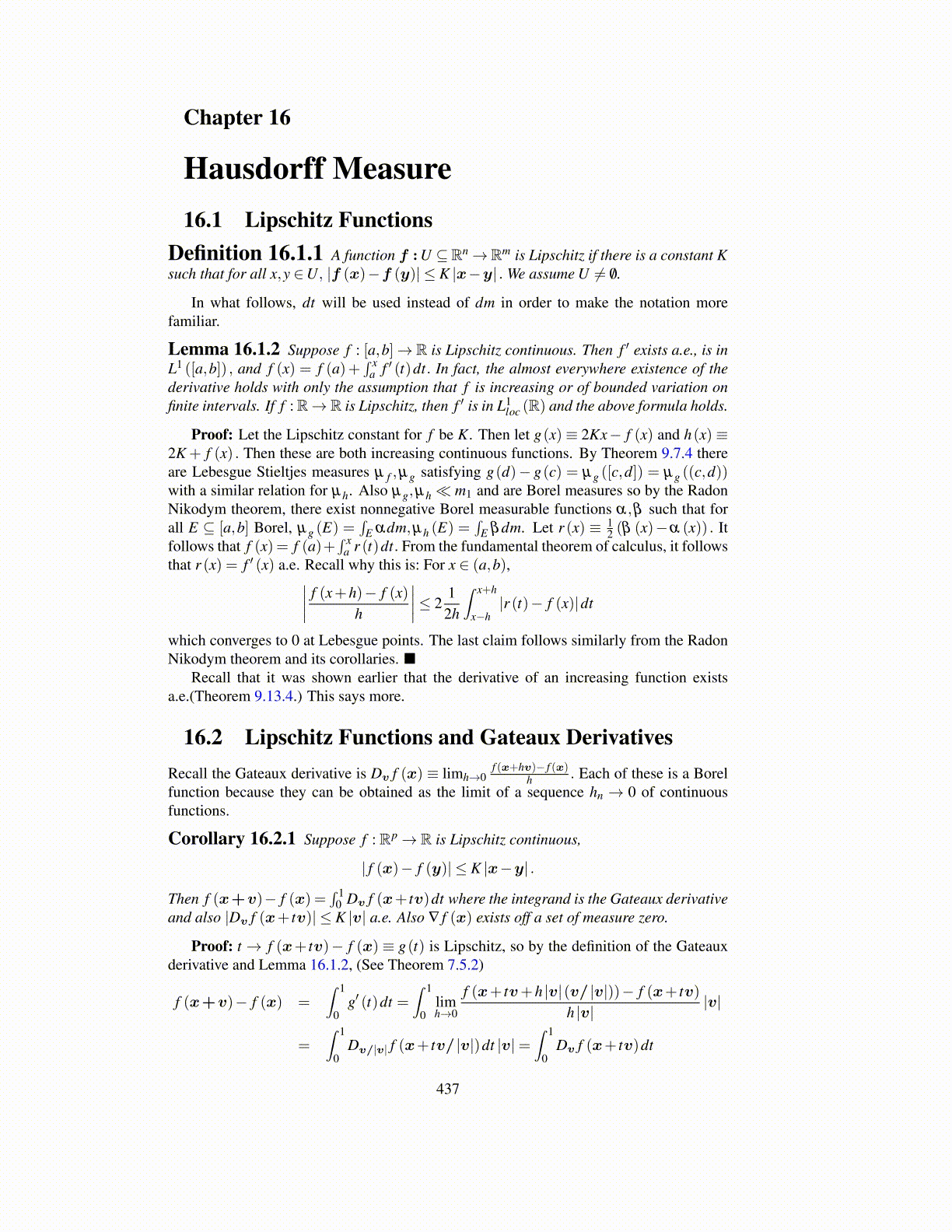
Chapter 16
Hausdorff Measure16.1 Lipschitz Functions
Definition 16.1.1 A function f :U ⊆Rn→Rm is Lipschitz if there is a constant Ksuch that for all x,y ∈U, |f (x)−f (y)| ≤ K |x−y| . We assume U ̸= /0.
In what follows, dt will be used instead of dm in order to make the notation morefamiliar.
Lemma 16.1.2 Suppose f : [a,b]→ R is Lipschitz continuous. Then f ′ exists a.e., is inL1 ([a,b]) , and f (x) = f (a)+
∫ xa f ′ (t)dt. In fact, the almost everywhere existence of the
derivative holds with only the assumption that f is increasing or of bounded variation onfinite intervals. If f :R→ R is Lipschitz, then f ′ is in L1
loc (R) and the above formula holds.
Proof: Let the Lipschitz constant for f be K. Then let g(x)≡ 2Kx− f (x) and h(x)≡2K + f (x) . Then these are both increasing continuous functions. By Theorem 9.7.4 thereare Lebesgue Stieltjes measures µ f ,µg satisfying g(d)− g(c) = µg ([c,d]) = µg ((c,d))with a similar relation for µh. Also µg,µh≪ m1 and are Borel measures so by the RadonNikodym theorem, there exist nonnegative Borel measurable functions α,β such that forall E ⊆ [a,b] Borel, µg (E) =
∫E αdm,µh (E) =
∫E βdm. Let r (x) ≡ 1
2 (β (x)−α (x)) . Itfollows that f (x) = f (a)+
∫ xa r (t)dt. From the fundamental theorem of calculus, it follows
that r (x) = f ′ (x) a.e. Recall why this is: For x ∈ (a,b),∣∣∣∣ f (x+h)− f (x)h
∣∣∣∣≤ 21
2h
∫ x+h
x−h|r (t)− f (x)|dt
which converges to 0 at Lebesgue points. The last claim follows similarly from the RadonNikodym theorem and its corollaries. ■
Recall that it was shown earlier that the derivative of an increasing function existsa.e.(Theorem 9.13.4.) This says more.
16.2 Lipschitz Functions and Gateaux DerivativesRecall the Gateaux derivative is Dv f (x) ≡ limh→0
f (x+hv)− f (x)h . Each of these is a Borel
function because they can be obtained as the limit of a sequence hn → 0 of continuousfunctions.
Corollary 16.2.1 Suppose f : Rp→ R is Lipschitz continuous,
| f (x)− f (y)| ≤ K |x−y| .
Then f (x+v)− f (x) =∫ 1
0 Dv f (x+ tv)dt where the integrand is the Gateaux derivativeand also |Dv f (x+ tv)| ≤ K |v| a.e. Also ∇ f (x) exists off a set of measure zero.
Proof: t → f (x+ tv)− f (x) ≡ g(t) is Lipschitz, so by the definition of the Gateauxderivative and Lemma 16.1.2, (See Theorem 7.5.2)
f (x+v)− f (x) =∫ 1
0g′ (t)dt =
∫ 1
0limh→0
f (x+ tv+h |v|(v/ |v|))− f (x+ tv)h |v|
|v|
=∫ 1
0Dv/|v| f (x+ tv/ |v|)dt |v|=
∫ 1
0Dv f (x+ tv)dt
437